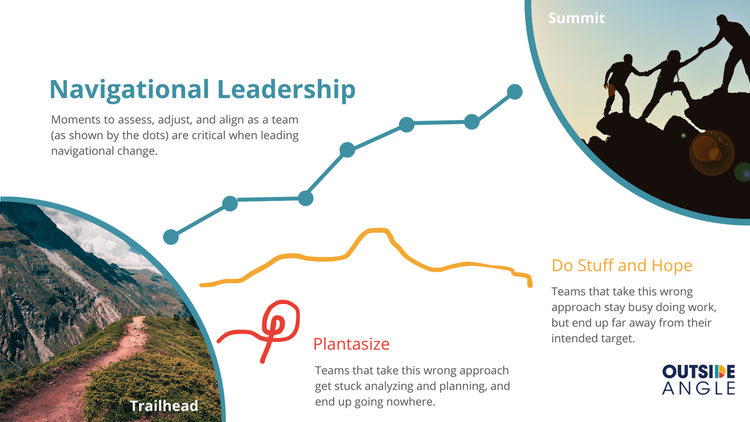In Laurence Gonzales’ book Deep Survival he writes about two bad approaches to surviving life or death situations. One of these bad approaches is to stay attached to the original plan. Some people, finding themselves in life or death situations, stay so fixated on their original plan that it kills them. On the other hand, those who develop no plan and become paralyzed by their circumstances also die. Survivors are the ones who adjust their mental model based on changing circumstances, come up with new plans, and “break down large jobs into small manageable tasks.”
This survivor approach is actually the essence of effective change leadership. The best change leaders have plans, but hold them lightly. They keep moving instead of getting stuck in cycles of planning. They exhibit tremendous fortitude, but also are able to laugh at themselves and find moments of wonder and humor in their predicament. They find the right balance between vision, process, and problem solving. This is what we call navigational leadership. It is not a term we coined, but it is a passionate belief we hold about the kind of leadership suited for leading challenging change.
Just like Gonzales’ findings about who dies on the mountain, we find that some leaders fall into thinking and behavior patterns that inhibit their ability to lead effective change. One of these profiles we call “Do Stuff and Hope”; the other we call “Plantasizing.”
Do Stuff and Hope
Some teams are extremely busy in pursuit of the change they seek. They are expending tremendous energy doing, doing, doing. But they have no real idea if their activity is actually taking them to the vision they seek. Often they actually have a vague (or not so vague) idea that it isn’t, but they keep going anyway with the hope that if they just keep doing stuff they’ll get there. These cases are much more like Gonzales’ first hiker profile—the one who won’t give up on the summit they’re sure they’ll get to if they just keep at it… until they die.
Plantasizing
Other teams are absolutely stuck. They’re scared to leave the port in the first place. They analyze and study and sometimes write beautiful “strategic plans” about they journey they are scared to begin and sometimes have no real intention of taking. It can feel much safer to stick with the status quo and “plantasize” about a different future. We call it “plantasizing” because it’s a mixture of planning and fantasizing without really doing anything. These cases are much more like Gonzales’ second hiker profile—the one who waits to be rescued on the mountain, curling up in a ball until they succumb to hypothermia.

Navigational Leadership
The better path is the navigational one. It involves having a vision for where you are going, and then regularly pausing to evaluate progress. Hypotheses are tested, and big challenges are broken down into smaller tasks. Action is constantly taken focused on doing the next thing. As one of our clients likes to say, they “slice the apple.” Then, along the way, they purposefully pause and reevaluate. These are the moments when the whole team stops and looks around to see if they are on course or need to adjust the plan again. They interrogate progress honestly and learn together, holding nothing sacred.
There are ways that this navigational leadership approach can be built into a team’s culture: its mindsets, behaviors, expectations, and processes. It can be taught, and it can be learned. But it is best learned by doing.
Navigational Leadership Can Be Learned
There are simple steps that individuals and organizations can take to make sure they aren’t wandering off into the wilderness hoping they’ll hit their desired destination, or stuck on the mountain plantasizing about what they should do.
-
Cultivate navigational mindsets. Humility, fortitude, positivity. These are all key to navigating through hard journeys together.
-
Remember your why. Let this continue to motivate you and be the north star that you are moving towards.
-
Stay curious. Stop regularly to honestly assess where you are. Have the courage to admit you’re off track, and adjust accordingly.
-
Celebrate progress. Small wins build morale and momentum. Winning teams are created by winning.
-
Embrace the tensions; strive for balance. It’s harmony between vision and process, technical and adaptive, moving and measuring.
Like successful wilderness survival, navigational change leadership is a manifestation of mindsets, skills, and instincts developed over the course of a lifetime. Training can help with many of the building blocks, but there’s no substitute for learning by doing.
One of our core values at Outside Angle is “progress over planning.” Simply put, we believe it is better to get things done than to talk about getting things done. Teams must jump headfirst into getting the work done according to the plan, while keeping their eyes and ears open to signals that a shift is needed.
Have a Process to Adjust Course and Stay Aligned As a Team
Navigational change leaders put in place purposeful points in time for coming together to honestly interrogate progress, and make the next plan. These are the dots on the green line in the graphic, and they’re especially important when you’re going on this journey together as a team. Otherwise, even if the leader is navigating, it’s likely that some others will be veering off on either side.
Many organizations undervalue and underinvest in these moments for taking stock. Other organizations make these moments into events that sell the plan more than create space to interrogate it. There’s little value in bringing people together to convince them of something that no one can know.
Truly navigational teams embrace these opportunities to take stock, and align on the next tree or bend in the road for everyone to hike towards—maybe also to celebrate progress or even to laugh together at how far off course they just found themselves when they stopped to check.
The more that organizations create these “stocktake” moments and stick with this practice over time, the more they will learn to use them effectively. Gradually, mindsets will begin to shift and people will begin to learn how it works and what is expected. They will prepare more rigorously, and engage more transparently.
Come Through It Alive
While organizational change may not be a true life or death matter of survival, the imagery and analogy are useful as we think about what it takes to lead teams through change. Too many organizations find themselves stuck in either the “Do Stuff and Hope” category or on the “Plantasizing” path. In both of these situations, the fact is that teams are still investing tons of energy in mind, body, and spirit to reach their goals; they’re just doing so in ways that aren’t moving the boat toward the vision.
Navigational leadership, on the other hand, gives teams a fighting chance at coming through it all alive by seeing challenges and opportunities clearly, testing and learning from hypotheses, adjusting the plan accordingly, and doing it all as an aligned team. Those who adopt a navigational approach are the ones who survive and live to tell about it.

